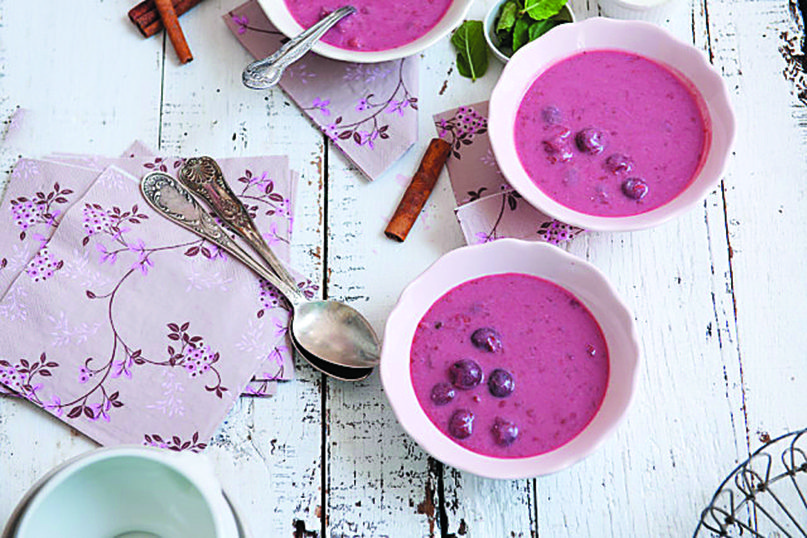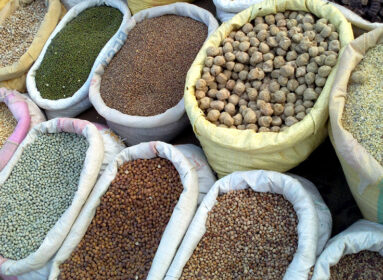
By Susan Barocas
When my seven-year-old son and I traveled to Budapest in 2002, we arrived at my friend Katalin’s flat at 11 a.m. It was already over 90 degrees F. and there was no air conditioning. After some 30 hours of travel, we were hungry.
Katalin, the daughter of Holocaust survivors who returned to Budapest after World War II, had anticipated what our condition would be and prepared something I had never had before – a refreshing cold cherry soup, spiced with cinnamon and cloves and thickened with sour cream. I was hooked.
Since then, every summer I make my own, much less labor-intensive version of cold cherry soup. Unlike Katalin, who stood for hours pitting the deeply scarlet fresh sour cherries (for which I am still grateful), I use a mix of frozen and jarred pitted sour cherries in syrup. Since the jars are imported from Hungary, I feel somehow connected to the traditional recipe.
Jews have a long tradition of cold summer soups. Central Europeans, especially Hungarians and Romanians, are known for fruit soups cooked, then chilled, like the cherry soup. Think compotes of summer stone fruits like peaches, cherries and plums, sometimes apples or pears, sweetened with just enough sugar to enhance the fruit. The pareve soups are flavored with various combinations of cinnamon, cloves, vanilla and lemon juice, and thinned with water or wine. Once chilled, sour cream is often added before serving the refreshing dish as an appetizer or the meal itself with some good bread.
Russian Jews, who favor more savory cold soups, are known for beet borscht and schav, a soup made from sorrel. Also called sour grass, sorrel is a tangy herb with leaves that look like spinach. Its sour taste comes from oxalic acid, which also gives rhubarb its tartness. Sorrel was used to brighten the taste of heavy foods in ancient Egypt, Greece and Rome. Later the French planted it to use for flavor as well as medicinally, as it aids digestion and treats liver problems, among other healing qualities.
Sorrel grows wild in Eastern Europe from April through June and can be found in the U.S. thriving in all kinds of conditions. Most of us head to farmers markets to find some sold in bunches. Poor Russian Jewish peasants usually added potatoes and sour cream to their schav for a hearty meal served with dark bread. If there was an egg to spare, it went in, too. Today, schav recipes mostly include eggs and lemons as well as sour cream. Many leave out the potatoes for a lighter dish.
And then there’s borscht. Beets, like potatoes, are a root vegetable that thrives even in imperfect growing conditions, and both keep well in cellars over long, cold winters. You can make a flavorful version of borscht (unlike that found in jars on grocery store shelves) by adding a carrot, a clove of fresh garlic, some fresh or dried dill, and a pinch of sugar to a pot with a few peeled beets and an onion, all cut into chunks. Cover with water, cook until soft and then puree the mixture. Serve it very cold with a dollop of sour cream or yogurt and some chopped chives or fresh dill.
The Jewish tradition of cold soups is not just an Ashkenazi thing. Chilled yogurt and cucumber soups have been eaten as long as remembered in Syria, Persia/Iran, Iraq, Turkey and most countries of the Middle East, each adding variations to the basic yogurt-cucumber-garlic mixture, diluted with a little milk or water. An Egyptian version of the soup is cooked with onion, spinach and rice before mixing in yogurt, cucumber and mint. Other variations added to the cold soup include seedless grapes, raisins, pickled cucumbers, scallions or ground nuts with the amount and types of herbs and garlic depending on availability and personal preference.
A longtime fan of cold soups, I serve them often, joining a long and delicious Jewish warm-weather tradition.
This article originally appeared on The Nosher.
A Hungarian Favorite: Sour Cherry Soup
Ingredients:
2 Tablespoons flour
1 1/2 cups sour cream
1 cinnamon stick
3 Tablespoons lemon juice
1/4 cup sugar
1 cup unsweetened sour or tart cherry juice
1 cup water
2 (1/2-inch) strips lemon zest
24 ounces or 2 jars pitted sour cherries in liquid
Directions:
Strain liquid from jarred cherries into a saucepan (there should be about 2 1/2 cups liquid), reserving cherries. Add unsweetened sour cherry juice, water, lemon juice, sugar, cinnamon stick, and lemon zest.
Bring to boil, reduce heat, and simmer for ten minutes. While mixture is simmering, combine 1 cup sour cream and flour in a medium-sized bowl with a whisk and reserve. Remove cherry liquid from heat, remove lemon zest and cinnamon, and cool slightly, about three minutes.
Add 1/2 cup of the cooled cherry liquid to the flour mixture and whisk until smooth. Whisk in cooled cherry liquid until combined, add reserved cherries, and simmer for five minutes, or until slightly thickened.
Remove from heat and chill at least two hours. Ladle into bowls and top with additional sour cream, if desired.







 Southern New England Jewish Ledger
Southern New England Jewish Ledger














